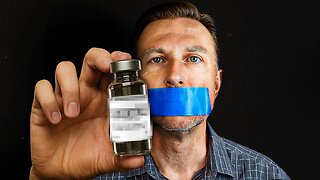Premium Only Content

Plastic Pollution: Good and Bad News
What’s the deal with plastic pollution? Here’s the good and bad news!
Timestamps
0:00 Introduction: Plastic Pollution
0:10 The bad news about plastic pollution
0:53 The seven types of plastic
1:21 The good news about plastic pollution
2:13 How to detoxify plastics
3:11 Share your success story!
DATA:
https://www.ncbi.nlm.nih.gov/pmc/articles/PMC3504417/
https://www.greatplainslaboratory.com/gpl-tox
Water Filters: https://crystalquest.com/pages/drinking-water-filter-systems
In this video, we’re going to talk about the good and bad news about plastic pollution.
The bad news about plastic pollution is that there is a lot of plastic in our environment. There were about 100 million metric tons of plastic in the environment as of 2016—there's likely far more than this amount today.
Every year, there are 8 million tons of plastic dumped in the oceans—mostly from rivers that lead to our oceans.
We all swallow and breath two thousand tiny pieces of plastic every week, which measures out to be around 5 grams of plastic. This is the equivalent of a credit card… EVERY WEEK!
The most common foods and drinks that contain plastic are:
• Water
• Shellfish
• Salt
• Beer
There are seven different types of plastic commonly used in products today. On most plastic products, you will find a triangle that indicates a type of plastic using a number between 1 and 7.
There is some good news about plastic pollution. In 2016, a group of researchers in Japan found that certain types of bacteria are able to break down plastic. These bacteria degrade plastics using an enzyme called petase, and they use carbon from plastics as their primary energy source.
Scientists genetically modified these bacteria to break down plastic 90% faster. These bacteria can now break down 90% of plastic in 10 hours.
There are also other useful ocean cleanup technologies that can…
1. Isolate where the plastic is
2. Concentrate the plastic
3. Extract the plastic
There are certain ways you can support your body’s removal of plastic toxins…
• Take calcium-D-glucarate
• Increase cruciferous vegetables in your diet
• Increase sweating
• Filter your water
Dr. Eric Berg DC Bio:
Dr. Berg, age 57, is a chiropractor who specializes in Healthy Ketosis & Intermittent Fasting. He is the author of the best-selling book The Healthy Keto Plan, and is the Director of Dr. Berg Nutritionals. He no longer practices, but focuses on health education through social media.
Follow Me On Social Media:
Facebook: https://bit.ly/FB-DrBerg
Instagram: https://bit.ly/IG-DrBerg
Anchor: https://bit.ly/Anchor-DrBerg
TikTok: https://bit.ly/TikTok-DrBerg
Send a Message to his team: https://m.me/DrEricBerg
Disclaimer:
Dr. Eric Berg received his Doctor of Chiropractic degree from Palmer College of Chiropractic in 1988. His use of “doctor” or “Dr.” in relation to himself solely refers to that degree. Dr. Berg is a licensed chiropractor in Virginia, California, and Louisiana, but he no longer practices chiropractic in any state and does not see patients so he can focus on educating people as a full time activity, yet he maintains an active license. This video is for general informational purposes only. It should not be used to self-diagnose and it is not a substitute for a medical exam, cure, treatment, diagnosis, and prescription or recommendation. It does not create a doctor-patient relationship between Dr. Berg and you. You should not make any change in your health regimen or diet before first consulting a physician and obtaining a medical exam, diagnosis, and recommendation. Always seek the advice of a physician or other qualified health provider with any questions you may have regarding a medical condition.
#keto #ketodiet #weightloss #ketolifestyle
Thanks for watching. I hope this helped explain the good and bad news about plastic pollution. I’ll see you in the next video.
-
 6:38
6:38
Dr. Eric Berg
5 days agoThe Shocking Truth About Vaccines
6.31K55 -
 LIVE
LIVE
Kimberly Guilfoyle
1 hour agoFull Breaking News Coverage: Live with John Nantz & Steve Moore | Ep250
418 watching -
 1:15:19
1:15:19
vivafrei
2 hours agoShameless Politicization of Tragedy! Susan Monarez is OUT! Pritzker is an IDIOT! & MORE!
82.8K22 -
 LIVE
LIVE
Major League Fishing
6 days agoLIVE! - Fishing Clash Team Series: Challenge Cup - Day 5
394 watching -
 1:49:30
1:49:30
The Quartering
3 hours agoCount Dankula Live On Migrant Crisis In Europe, Whiteness & More
107K117 -
 3:46:59
3:46:59
Barry Cunningham
7 hours agoBREAKING NEWS: KAROLINE LEAVITT HOLDS WHITE HOUSE PRESS CONFERENCE (AND MORE NEWS)
61.9K41 -
 47:21
47:21
Stephen Gardner
20 hours ago🔥Elon Just Exposed the Most Corrupt Man on Earth - Trump Makes BOLD MOVE!
21K96 -
 LIVE
LIVE
The HotSeat
1 hour agoI'm NOT Sorry! Guns Aren’t the Problem—Godless Culture Is
607 watching -
![[Ep 737] Media & Left Attack Prayer and God | Media Loses Control of Narrative | CDL Fraud](https://1a-1791.com/video/fww1/ca/s8/1/m/N/f/d/mNfdz.0kob-small-Ep-736-Make-Gender-Dysphori.jpg) LIVE
LIVE
The Nunn Report - w/ Dan Nunn
1 hour ago[Ep 737] Media & Left Attack Prayer and God | Media Loses Control of Narrative | CDL Fraud
189 watching -
 2:53:12
2:53:12
Right Side Broadcasting Network
7 hours agoLIVE REPLAY: White House Press Secretary Karoline Leavitt Holds a Press Briefing - 8/28/25
111K43